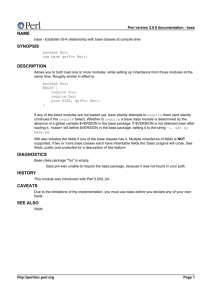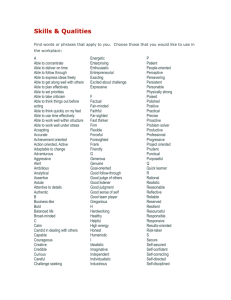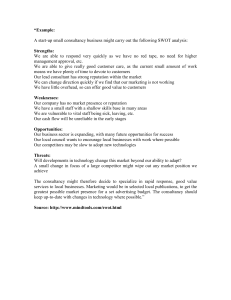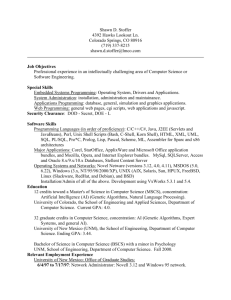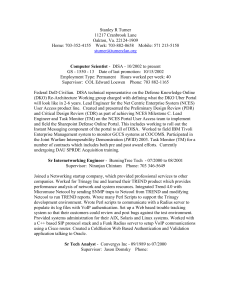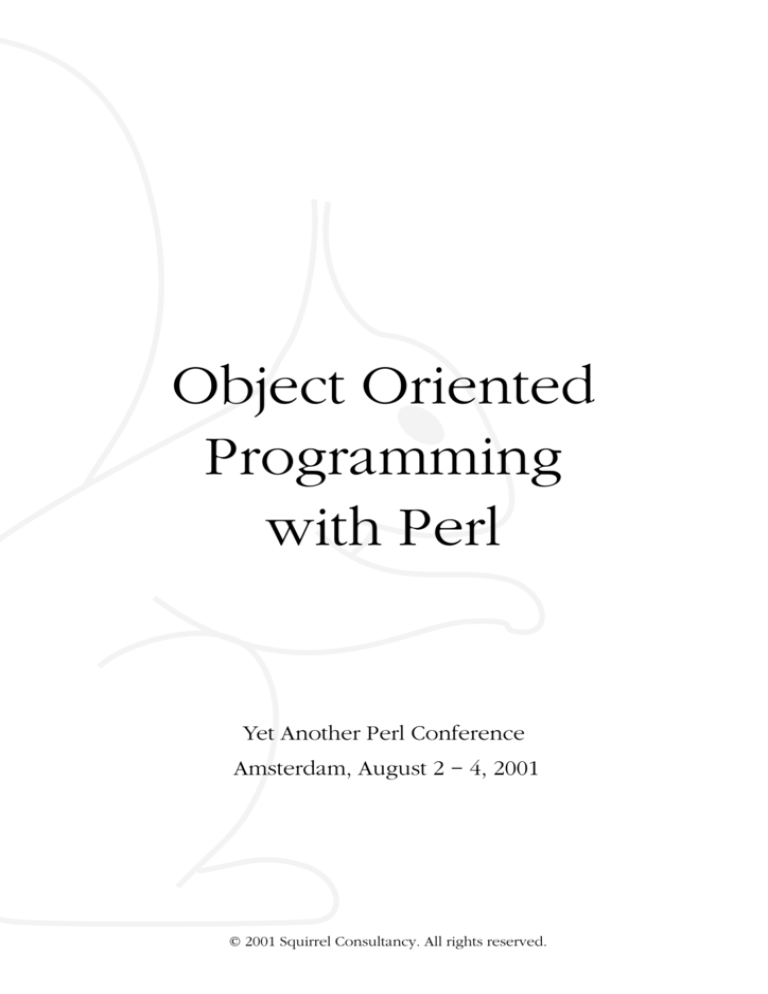
Object Oriented
Programming
with Perl
Yet Another Perl Conference
Amsterdam, August 2 − 4, 2001
© 2001 Squirrel Consultancy. All rights reserved.
Squirrel Consultancy
Object Oriented Programming with Perl
Preface
© 2001 Squirrel Consultancy. All rights reserved.
1
Squirrel Consultancy
Object Oriented Programming with Perl
Object Oriented
Programming with Perl
Johan Vromans
Squirrel Consultancy
<JVromans@Squirrel.NL>
Object Oriented Programming with Perl / Johan Vromans
1
Object Oriented Programming with Perl
This document contains selected sheets from the training “Object
Oriented Programming with Perl”.
For the complete materials, please contact Squirrel Consultancy,
<info@squirrel.nl>.
Object Oriented Programming with Perl / Johan Vromans
© 2001 Squirrel Consultancy. All rights reserved.
2
2
Squirrel Consultancy
Object Oriented Programming with Perl
Part I
© 2001 Squirrel Consultancy. All rights reserved.
3
Squirrel Consultancy
Object Oriented Programming
It’s all about objects, that are instances of classes that supply methods,
either directly or via inheritance from base classes. Derived classes can
use polymorphism to tailor inherited methods to their specific needs,
and abstraction keeps implementation details out of the way.
Despite popular belief, object oriented programming is not something
new. The idea of programming in terms of objects goes back to the
mid-1960s, when Ole Dahl and Kirsten Nygaart in Norway created the
language Simula for simulating physical processes.
Object Oriented Programming with Perl / Johan Vromans
4
Classes
Classes are the heart of the objects system.
Name space with data and routines (behavior).
Usually related to one specific kind of problem.
Object Oriented Programming with Perl / Johan Vromans
5
Objects
An object is a data structure that belongs to (is an instance of) a class.
Every object knows which class it belongs to.
Objects’ behavior is supplied by the class.
The object data are called attributes.
Object Oriented Programming with Perl / Johan Vromans
© 2001 Squirrel Consultancy. All rights reserved.
6
4
Squirrel Consultancy
Methods
The class defines methods: behaviors that apply to the class and its
instances.
If a method ‘does something’ related to the object data, it is called an
instance method.
Otherwise, it is called a class method.
A special kind of method are constructor methods: these methods
create new objects.
Object Oriented Programming with Perl / Johan Vromans
7
Inheritance
A class may inherit methods
from other classes.
If class B inherits methods from
class A, then class A is a parent
class (base class, superclass,
generalization) of class B. Class
B is derived from (is a subclass
of, a specialization of ) class A.
Class B has an is-a relation with
class A.
A
attributes
methods
B
attributes
methods
Object Oriented Programming with Perl / Johan Vromans
8
Polymorphism
Objects can use inheritance for methods, but they can also supply
their own specific implementation by overriding methods from the
base class. They can even use the base class methods when rolling
their own.
Object Oriented Programming with Perl / Johan Vromans
© 2001 Squirrel Consultancy. All rights reserved.
9
5
Squirrel Consultancy
Encapsulation
Application programs do not need to know what’s inside the object.
The object encapsulates its inner guts.
All access to an object should go through methods alone.
Methods that exclusively set and get attribute values are called
attribute accessors.
Object Oriented Programming with Perl / Johan Vromans
10
Abstraction
Since all access goes through methods, the underlying details are
abstracted out.
The interface is what is important to the user of the objects, not how it
is implemented.
Object Oriented Programming with Perl / Johan Vromans
11
Object Oriented Programming
Why?
Object Oriented Programming with Perl / Johan Vromans
© 2001 Squirrel Consultancy. All rights reserved.
12
6
Squirrel Consultancy
Object Oriented Programming with Perl
Part II
© 2001 Squirrel Consultancy. All rights reserved.
7
Squirrel Consultancy
Classes
A class is simply a package.
It provides the name space to hold data and subroutines.
Often, a module is used to hold one or more classes.
Object Oriented Programming with Perl / Johan Vromans
14
Objects
An object is simply a referent.
A reference pointing to the referent is used to represent the object.
The association between a package (class) and the referent (object) is
made using Perl’s builtin bless function.
Usually, the class defines one or more methods that return a new
object: constructor methods.
Often, one of the constructor methods is called new so you can say:
$myobj = new MyClass::;
Object Oriented Programming with Perl / Johan Vromans
15
Methods
A method is simply a subroutine.
Method invocation is a subroutine call with a twist.
Two ways to invoke a method:
• as a dereference
• using indirect object syntax
Object Oriented Programming with Perl / Johan Vromans
© 2001 Squirrel Consultancy. All rights reserved.
16
8
Squirrel Consultancy
Method Invocation as a Dereference
invocant->method(args, ...)
The invocant can be the name of the class (for class methods), or an
instance of the class.
The subroutine gets the invocant as its first argument, before the
supplied arguments.
Class names are best specified with two trailing colons, e.g.
MyClass::. This prevents them from being taken for the name of a
subroutine.
Object Oriented Programming with Perl / Johan Vromans
17
Method Invocation using Indirect Object Syntax
method invocant (args, ...)
method invocant args, ...
The subroutine gets the invocant as its first argument, before the
supplied arguments.
The indirect object syntax suffers from syntactic ambiguity.
Object Oriented Programming with Perl / Johan Vromans
18
Method Invocation using Subroutine Call
method(invocant,args,...)
The method name must be fully qualified, since object oriented
packages do not normally export subroutines.
We’ll see later why this way of invocation is a bad idea.
Object Oriented Programming with Perl / Johan Vromans
© 2001 Squirrel Consultancy. All rights reserved.
19
9
Squirrel Consultancy
Inheritance
When a method is invoked on an invocant, the invocant may either
provide the method itself (by defining the appropriate subroutine), or
inherit the method from one of its base classes.
Perl decides at invocation time which subroutine to call.
Therefore, method invocation is slightly slower than straight
subroutine calls.
Also, no prototype checking is possible.
Object Oriented Programming with Perl / Johan Vromans
20
Inheritance
A class can register its base classes by storing their names in a package
array @ISA.
For example:
package Vowel;
use Letter;
our @ISA = qw(Letter);
But it’s better (and easier) to use the base pragma:
package Vowel;
use base qw(Letter);
Object Oriented Programming with Perl / Johan Vromans
21
UNIVERSAL
A special pre-defined class UNIVERSAL is the ultimate ancestor from
which all classes implicitly derive.
It provides methods to query whether a class derives from some other
class, and if it can perform a certain method.
Methods can be added to class UNIVERSAL, but beware! Some other
class may not expect to find it.
Object Oriented Programming with Perl / Johan Vromans
© 2001 Squirrel Consultancy. All rights reserved.
22
10
Squirrel Consultancy
Polymorphism
Derived classes can add, and override, any methods of the base
classes.
When a method is called, perl first looks in the class the object
belongs to.
If not found, it searches the class hierarchy.
Object Oriented Programming with Perl / Johan Vromans
23
Looking for Methods
When a method is called, perl first looks in the class the object
belongs to.
If not found, it runs a left-to-right, recursive, depth-first search on all
base classes.
If still not found, looks in class UNIVERSAL.
If still not found, the whole procedure is repeated but this time for a
subroutine named AUTOLOAD.
If no subroutine could be found, perl raises an exception.
Object Oriented Programming with Perl / Johan Vromans
24
Encapsulation
Perl provides several ways to hide private data from unwanted access.
Object Oriented Programming with Perl / Johan Vromans
© 2001 Squirrel Consultancy. All rights reserved.
25
11
Squirrel Consultancy
Abstraction
Perl makes it possible to have all data access go through methods,
leaving only the abstracted interface to the user of the objects.
Perl does, however, not enforce this.
There are ways to make unwanted access hard, if not impossible.
Object Oriented Programming with Perl / Johan Vromans
26
Object Destruction
Perl uses reference counting to keep track of allocated objects.
When an object goes out of scope or otherwise ceases to exist, it will
be garbage collected – eventually.
If the object can perform a DESTROY method, this is called by Perl
when the object is logically removed from the object system.
If it cannot, no special action is taken.
Object Oriented Programming with Perl / Johan Vromans
© 2001 Squirrel Consultancy. All rights reserved.
27
12
Squirrel Consultancy
Object Oriented Programming with Perl
Part III
© 2001 Squirrel Consultancy. All rights reserved.
13
Squirrel Consultancy
HTML::Head example
Let’s set up a simple class that implements HTML heading objects, like
<h1>...</h1>, <h2>...</h2>, and so on.
What we need:
• a constructor to create a heading object,
• a way to specify the level and the text, and
• a method to publish the object, i.e., create HTML text from it.
Object Oriented Programming with Perl / Johan Vromans
29
HTML::Head example – The Class
A class is simply a package.
package HTML::Head;
use strict;
1;
Object Oriented Programming with Perl / Johan Vromans
30
HTML::Head example – The Constructor
A constructor is simply a method that returns a blessed reference.
A method is simply a subroutine that gets its invocant passed as its first
argument.
# $obj = HTML::Head::->new;
sub new {
bless { };
}
The object is implemented using a hash.
Object Oriented Programming with Perl / Johan Vromans
© 2001 Squirrel Consultancy. All rights reserved.
31
14
Squirrel Consultancy
HTML::Head example – The Attributes
Attributes are the data of the instance. They are stored in the hash.
HTML::Head has two attributes: the text and the header level.
# $obj->set_level(2);
sub set_level {
my ($self,$level) = @_;
$self->{level} = $level;
}
# $lvl = $obj->get_level;
sub get_level {
my $self = shift;
$self->{level};
}
Object Oriented Programming with Perl / Johan Vromans
32
HTML::Head example – The Attributes
For boolean attributes, it is conventional to use set_attr and is_attr .
$obj->set_bold(1);
$obj->set_bold(0);
if ( $obj->is_bold ) { ... }
# on
# off
Please supply a sensible default value:
$obj->set_bold;
# on, not off!
Object Oriented Programming with Perl / Johan Vromans
33
HTML::Head example – The Constructor (revisited)
If the attributes are stored in a hash, it is convenient and easy to
initialize them at construction time:
# $obj = HTML::Head::->new(level=>2, text=>"Heading");
sub new {
shift;
bless { @_ };
}
# ignore invocant
This is much too simple, we need to do some integrity checking here.
Object Oriented Programming with Perl / Johan Vromans
© 2001 Squirrel Consultancy. All rights reserved.
34
15
Squirrel Consultancy
HTML::Head example – Other Methods
The publish method produces an HTML string for the instance.
sub publish {
my $self = shift;
"<h" . $self->get_level . ">" .
$self->get_text .
"</h" . $self->get_level . ">";
}
Isn’t it a bit overdone to use get_level and get_text from within
the class?
Object Oriented Programming with Perl / Johan Vromans
35
HTML::Head example – Array implementation
Any referent may be used as the object implementation. Hashes are
nice, but there’s nothing wrong with a plain array.
Let’s change the internal implementation from hash to array.
The constructor:
sub new {
shift;
# ignore invocant
my $obj = [ ];
my %init = @_;
$obj->[0] = delete $init{level};
$obj->[1] = delete $init{text};
bless $obj;
}
Object Oriented Programming with Perl / Johan Vromans
36
Constants
In situations like this, the constant pragma may be helpful.
use constant ATTR_LEVEL => 0;
use constant ATTR_TEXT => 1;
Object Oriented Programming with Perl / Johan Vromans
© 2001 Squirrel Consultancy. All rights reserved.
37
16
Squirrel Consultancy
HTML::Head example – The ‘text’ attribute
A straightforward change: replace the ‘->{text}’ with
‘->[ATTR_TEXT]’.
# $obj->set_text("Heading");
sub set_text {
my ($self, $text) = @_;
$self->[ATTR_TEXT] = $text;
}
# $text = $obj->get_text;
sub get_text {
my $self = shift;
$self->[ATTR_TEXT];
}
Object Oriented Programming with Perl / Johan Vromans
38
HTML::Head example – Other Methods
The publish method:
sub publish {
my $self = shift;
"<h" . $self->get_level . ">" .
$self->get_text .
"</h" . $self->get_level . ">";
}
Because we used get_level and get_text, the other methods do
not need to change when the implementation changes.
In general, it is good practice that only the constructor and attribute
get/set methods know about the inner details.
Object Oriented Programming with Perl / Johan Vromans
39
Hash versus Array
Arrays are slightly faster, but hard to maintain.
When inheritance gets into play, it becomes even harder.
Hashes are slightly slower, but more flexible.
Perl provides the best of both worlds: the pseudo-hash.
Special pragma’s: fields and base.
Object Oriented Programming with Perl / Johan Vromans
© 2001 Squirrel Consultancy. All rights reserved.
40
17
Squirrel Consultancy
HTML::Head example – Pseudo-Hash implementation
The fields pragma is used to define the fields that we’re going to
use.
package HTML::Head;
use strict;
use fields qw(level text);
Object Oriented Programming with Perl / Johan Vromans
41
HTML::Head example – The Constructor
The fields::new method creates a suitable object.
# $obj = HTML::Head::->new;
sub new {
my $invocant = shift;
my HTML::Head $obj = fields::new($invocant);
my %init = @_;
$obj->{$_} = $init{$_} foreach keys %init;
$obj;
}
Illegal values for attribute names are now trapped at run time.
Object Oriented Programming with Perl / Johan Vromans
42
HTML::Head example – The Attributes
# $obj->set_level(2);
sub set_level {
my HTML::Head $self = shift;
my $level = shift;
$self->{level} = $level;
}
# $lvl = $obj->get_level;
sub get_level {
my HTML::Head $self = shift;
$self->{level};
}
Object Oriented Programming with Perl / Johan Vromans
© 2001 Squirrel Consultancy. All rights reserved.
43
18
Squirrel Consultancy
HTML::Head example – Other Methods
Again, no changes for the other methods.
sub publish {
my $self = shift;
"<h" . $self->get_level . ">" .
$self->get_text .
"</h" . $self->get_level . ">";
}
Object Oriented Programming with Perl / Johan Vromans
44
Inheritance
As stated earlier, a class can either provide the method itself (by
defining the appropriate subroutine), or inherit the method from one
of its base classes.
For example, assume we have a base class HTML::Head, and two
derived classes, HTML::Head1 and HTML::Head2.
HTML::Head handles storing the text, while the derived classes
handle the publishing.
Object Oriented Programming with Perl / Johan Vromans
45
HTML::Head example with Derived Classes
package HTML::Head;
use strict;
sub new {
shift;
bless { @_ };
}
# ignore invocant
sub get_text { ... }
sub set_text { ... }
package HTML::Head1;
use base qw(HTML::Head);
sub publish { "<h1>@{[shift->get_text]}</h1>" }
Object Oriented Programming with Perl / Johan Vromans
© 2001 Squirrel Consultancy. All rights reserved.
46
19
Squirrel Consultancy
Inheritance and Constructors
The bless function blesses a reference in the current package. So it
will always become an instance of the class that declared the
constructor.
But what if the derived class inherits the constructor?
Objects created by the inherited constructor would end up being
instances of the base class, not of the derived class.
$h1 = HTML::Head1::->new;
This calls HTML::Head::new to create an HTML::Head object, and
will not produce an HTML::Head1 object.
Object Oriented Programming with Perl / Johan Vromans
47
Inheritance and Constructors (cont’d)
Remember, a method always gets its invocant as its first argument.
$h1 = HTML::Head1::->new;
This calls HTML::Head::new("HTML::Head1").
Object Oriented Programming with Perl / Johan Vromans
48
bless’ Second Argument
bless takes a second argument, the name of the class to bless the
object into.
We can use this to create an inheritable constructor.
sub new {
my $invocant = shift;
...
bless $obj, $invocant;
}
Object Oriented Programming with Perl / Johan Vromans
© 2001 Squirrel Consultancy. All rights reserved.
49
20
Squirrel Consultancy
Instance Methods as Constructors
While we’re at it: there is no reason to restrict object construction to
classes.
my HTML::Head $h1 = HTML::Head::->new;
my HTML::Head $h2 = $h1->new;
ref returns the package name of an object.
sub new {
my $invocant = shift;
...
bless $obj, ref($invocant) || $invocant;
}
Object Oriented Programming with Perl / Johan Vromans
50
Factory Methods
Methods that create objects are called factory methods.
A constructor is a special case of factory method: one that creates a
new instance for its class.
To distinguish factory methods from constructors, give them a catchy
name, like create_... or make_... .
Object Oriented Programming with Perl / Johan Vromans
51
Attribute Accessor Methods
Writing all those get_attr and set_attr methods gets boring soon.
One thing to try is combine the set and get methods:
# $obj->level(2);
# $lvl = $obj->level;
sub level {
my $self = shift;
$self->{level} = shift if @_;
$self->{level};
}
Object Oriented Programming with Perl / Johan Vromans
© 2001 Squirrel Consultancy. All rights reserved.
52
21
Squirrel Consultancy
Using Closures for Accessor Methods
For repetitive and otherwise boring tasks, use Perl.
foreach my $fld ( qw(level text) ) {
no strict ’refs’;
*{$fld} = sub {
my ($self) = shift;
$self->{$fld} = shift if @_;
$self->{$fld};
}
}
Object Oriented Programming with Perl / Johan Vromans
53
AUTOLOAD Accessor Methods
We can skip the definition of the accessor methods, and leave it to
AUTOLOAD to catch them.
sub AUTOLOAD {
my $self = shift;
croak "objects only, please" unless ref($self);
my $name = our $AUTOLOAD;
return if $name =˜ /::DESTROY$/;
if ( $name =˜ /ˆHTML::Head::(.*)/ and
$1 eq "text" || $1 eq "level" ) {
$self->{$1} = shift if @_;
return $self->{$1};
}
croak "undefined method $name called";
}
Object Oriented Programming with Perl / Johan Vromans
54
Class Data and Methods
Classes can have data, too.
These can be stored nice privately in lexical variables.
To allow derived classes to use the data, accessor methods are
needed, just as with instance data.
These methods do not need to pay attention to their first argument,
since they do not relate to any particular instance.
Object Oriented Programming with Perl / Johan Vromans
© 2001 Squirrel Consultancy. All rights reserved.
55
22
Squirrel Consultancy
Class Data and Methods (cont’d)
Assume, in our HTML::Head examples, that we want to keep track of
the number of allocated instances.
my $num_instances;
In the constructor:
$num_instances++;
Object Oriented Programming with Perl / Johan Vromans
56
Class Data and Methods (cont’d)
If we need the actual number of live instances, not just a tally, we
need a destructor method:
sub DESTROY {
$num_instances--;
}
Object Oriented Programming with Perl / Johan Vromans
57
Class Data and Methods (cont’d)
To access the class data from outside, or from a derived class, define
an accessor method:
sub instances {
shift;
$num_instances;
}
# ignore invocant
No matter where and how invoked, this method will always return the
value of the lexical.
Usually this is exactly what is desired.
Object Oriented Programming with Perl / Johan Vromans
© 2001 Squirrel Consultancy. All rights reserved.
58
23
Squirrel Consultancy
Privacy of Instance Data
Instance data in hashes and arrays is always vulnerable to unwanted
access.
Anyone having a reference can dereference it with
$obj->{priv_data}.
A common technique to obtain real private instance data is by storing
the data in a lexical hash, using the instance reference as the key.
Object Oriented Programming with Perl / Johan Vromans
59
Privacy of Instance Data (cont’d)
package Secure;
my %instance_data;
sub new {
...
my $self = bless {}, $class;
$instance_data{$self} = { attr => ... };
$self;
}
sub get_attr {
my $self = shift;
$instance_data{$self}{attr};
}
Object Oriented Programming with Perl / Johan Vromans
60
Using Separate Hashes
Using separate hashes for each attribute, typing errors can be caught.
It is slightly faster as well.
my %text;
my %level;
sub new {
...
my $self = bless {}, $class;
$text{$self} = undef;
$level{$self} = undef;
$self;
}
sub text {
my $self = shift;
@_ ? $text{$self} = shift : $text{$self};
}
sub level {
my $self = shift;
@_ ? $level{$self} = shift : $level{$self};
Object Oriented Programming with Perl / Johan Vromans
© 2001 Squirrel Consultancy. All rights reserved.
61
24
Squirrel Consultancy
Using Separate Hashes
}
Object Oriented Programming with Perl / Johan Vromans
62
Singleton Classes
Singleton, monadic or highlander classes are special in that there is
always no more than one instance.
Often there is no instance at all – the class just provides methods for
the application to use.
If there’s a constructor, it re-uses a single referent, or it returns just the
class name.
Object Oriented Programming with Perl / Johan Vromans
63
Oops!
Aren’t we forgetting something?
Object Oriented Programming with Perl / Johan Vromans
© 2001 Squirrel Consultancy. All rights reserved.
64
25
Squirrel Consultancy
Documentation
Any software system is essentially useless without proper
documentation.
This is particularly true for object based systems.
Every object based module should document:
• High level: how application programs should use it
• Medium level: how the module can be reused to form other
components.
• Low level: how the module can be maintained
If you want your module to be used, pay special attention to
documenting the high level API.
Object Oriented Programming with Perl / Johan Vromans
© 2001 Squirrel Consultancy. All rights reserved.
65
26
Squirrel Consultancy
Object Oriented Programming with Perl
Part V
© 2001 Squirrel Consultancy. All rights reserved.
27
Squirrel Consultancy
Overload
In the HTML examples, method publish produces an HTML string
representing the contents of an instance.
With overload, we can do this automatically when an object is
evaluated in string context.
use overload ’""’ => "publish";
Now, referencing an instance of HTML::Head in string context will
automatically call the publish method to produce the HTML string.
my $h1 = HTML::Head::->new(level=>1, text=>"A Title");
print STDOUT ("<html><body>\n",
"$h1\n",
"</body></html>\n");
Object Oriented Programming with Perl / Johan Vromans
67
Overload (cont’d)
Overloading of operators is also very convenient when the meaning
of operators can be extended to the objects.
For example, in the HTML::List example, concatenation could be
used to add another thing to the list:
{
package HTML::List::UnorderedList;
use overload "." => "add";
use overload ’""’ => "publish";
}
my $ul = HTML::List::UnorderedList::->new;
$ul->add("uitem1");
print STDOUT ($ul . "uitem2" . "uitem3", "\n");
Object Oriented Programming with Perl / Johan Vromans
68
Overload (cont’d)
Beware of unexpected results.
{
package HTML::List::UnorderedList;
use overload "." => "add";
use overload ’""’ => "publish";
}
my $ul = HTML::List::UnorderedList::->new;
$ul . "uitem1" . "uitem2" . "uitem3";
print STDOUT ("$ul\n");
Object Oriented Programming with Perl / Johan Vromans
© 2001 Squirrel Consultancy. All rights reserved.
69
28
Squirrel Consultancy
Overload (cont’d)
So this is probably the best to do:
{
package HTML::List::UnorderedList;
use overload ".=" => "add";
use overload ’""’ => "publish";
}
my $ul = HTML::List::UnorderedList::->new;
$ul .= "uitem1";
$ul .= "uitem2";
$ul .= "uitem3";
print STDOUT ("$ul\n");
Object Oriented Programming with Perl / Johan Vromans
70
Class::Struct
The standard Class::Struct module can be used to quickly setup
classes.
package HTML::Head;
use Class::Struct;
struct ( level => ’$’, text
=> ’$’ );
sub publish {
my $self = shift;
"<h" . $self->level . ">" .
$self->text .
"</h" . $self->level . ">";
}
1;
Object Oriented Programming with Perl / Johan Vromans
71
Class::MethodMaker
Powerful module to construct classes.
Supports several class creation styles: hashes, hash from args, hash
with init.
Supports several attribute access styles.
Lots of fancy things like abstract methods, class attributes, attribute
groupings and delegation.
Available on CPAN.
Object Oriented Programming with Perl / Johan Vromans
© 2001 Squirrel Consultancy. All rights reserved.
72
29
Squirrel Consultancy
Object Oriented Programming with Perl
Epilogue
© 2001 Squirrel Consultancy. All rights reserved.
30
Squirrel Consultancy
The Books
Object Oriented Perl
Damian Conway
Manning, 1999
ISBN 1-884777-79-1
Programming Perl, 3rd ed.
Larry Wall, Tom Christiansen & Jon Orwant
O’Reilly & Associates, 2000
ISBN 0-596-00027-8
Object Oriented Programming with Perl / Johan Vromans
74
The Perl Docs
perlobj:
Perl Objects
perlboot: Beginner’s Object Oriented Tutorial
Randal L. Schwartz
perltoot: Tom’s Object-Oriented Tutorial
Tom Christiansen
perltootc: Tom’s Object-Oriented Tutorial for Class Data
Tom Christiansen
perlbot:
Bag’o Object Tricks
Object Oriented Programming with Perl / Johan Vromans
© 2001 Squirrel Consultancy. All rights reserved.
75
31

